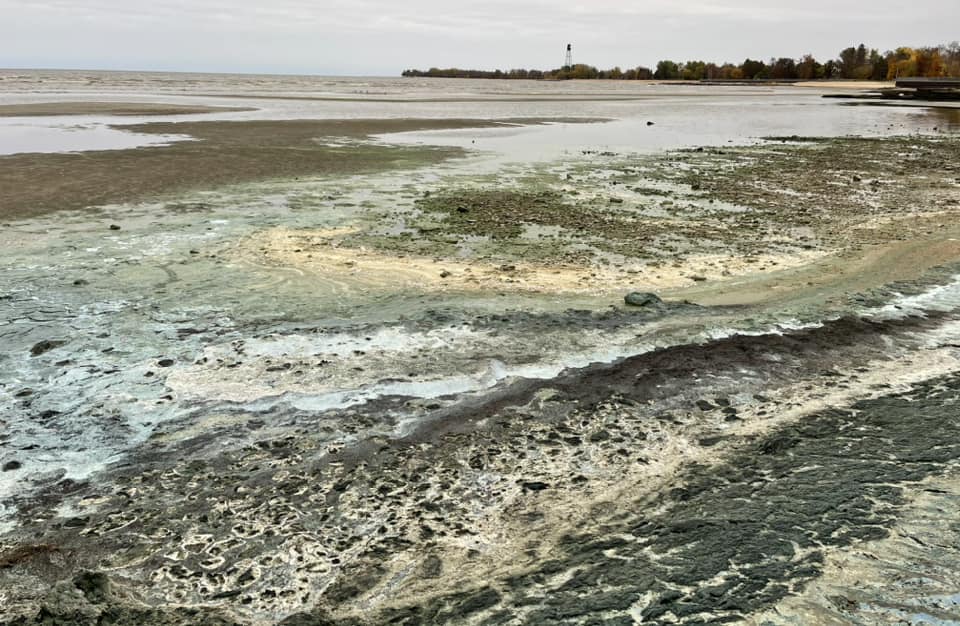Lake Winnipeg is contending with an increasing amount of algae, resulting in unintended consequences.

With Lake Winnipeg facing down an algae bloom, fish are paying the price. Large quantities of the aquatic plant kill fish when it decomposes and removes oxygen from the water. Alexis Kanu, executive director of the Lake Winnipeg Foundation, said one of the causes of such a bloom is phosphorous.
“Phosphorous is a nutrient that gets flushed into our waterways and makes its way into Lake Winnipeg. It’s the driving force behind the growth of these blooms,” Kanu said. “People who live and work on the lake have been reporting these blooms for decades. Unfortunately, we’re still not seeing the action that we need from government on this issue.”
Phosphorous, Kanu said, is a nutrient for plants. It’s what controls the growth of algae, and putting an excess of it into waterways can feed the bloom. The way to solve this, she said, is by regulating activities that generate a surplus of the nutrient. She pointed at things like human and animal waste that can produce phosphorous.
Regulating how sewage treatment plants can operate, she said, would reduce the flow of the nutrient into the lake.
Kanu noted that at the city’s North End sewage treatment plant, the limit of production of phosphorous has not been met — with the limit sitting at one milligram per litre.
Global News reached out to the City of Winnipeg about the facility’s compliance. In an emailed statement on Oct. 3, the city’s water and waste department said there are months in which the treatment plant is in compliance with the phosphorous levels. In other months, it said, the plant is not.
The department further added that there are two capital projects underway at the plant to help meet complaint levels. The first of these projects is an upgrade to the facility, expected to be commissioned by 2030, which would aim to reduce the nutrient’s level by biological means to one milligram per litre.

Get breaking National news
The other project is the Interim Chemical Phosphorous Removal project, currently in construction and expected to be up and running early next year. It’s a project described as using ferric chloride to chemically remove phosphorous.
An algae bloom on Lake Winnipeg may be a result of an increased flow of phosphorous into the waterway, according to experts.
Another avenue of phosphorous production is farming, according to Michael Rennie.
Rennie, an ecologist and research fellow with the IISD Experimental Lakes Area, said major industrial changes need to be made to solve the problem of algae blooms. Otherwise, a ripple effect caused by the consequences of having more algae can be detrimental. And it would put at risk not only fishing and recreation, he said, but also the entire health of Lake Winnipeg.
“If you start dramatically changing abundances of particular food web components in any ecosystem, whether it’s lake whitefish or walleye or anything else, that’s going to have knock-on effects right across the board,” Rennie said.
Rick Gergatz, the administrator of The Lake Winnipeg Report, a Facebook page dedicated to informing residents about the conditions on the lake, said he’s received photos from many people pointing to the presence of algae across the lake’s shoreline.
He noted that the plant’s presence seems to be more concentrated on the west side.
“Anywhere from Winnipeg Beach all the way up to Sandy Bar, and even into Hecla area,” Gergatz said. “Algae is normal, excessive algae is not. That’s what we’re getting right now. And (it’s) because we’re treating the lake as our sewage lagoon.”
According to Gergatz, the problem is being compounded. With the damage already done, he said, it’s time to “smarten up.” One way to do so would be to regulate the city’s North End treatment plant, he added.
Ultimately, to Gergatz, Lake Winnipeg has always been beautiful. He said he just wants to see it treated right.
— with files from Global’s Katherine Dornian











Comments